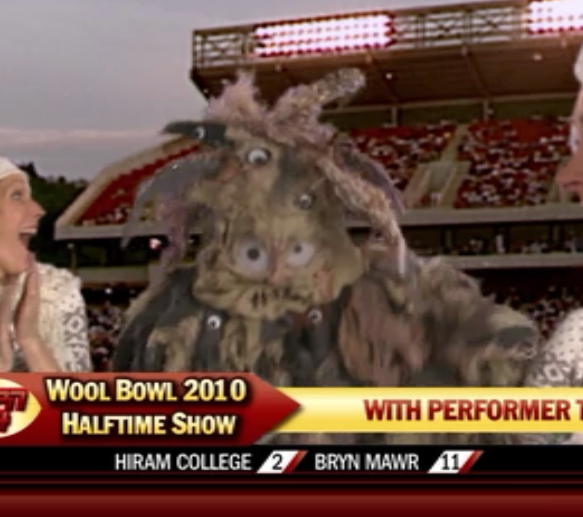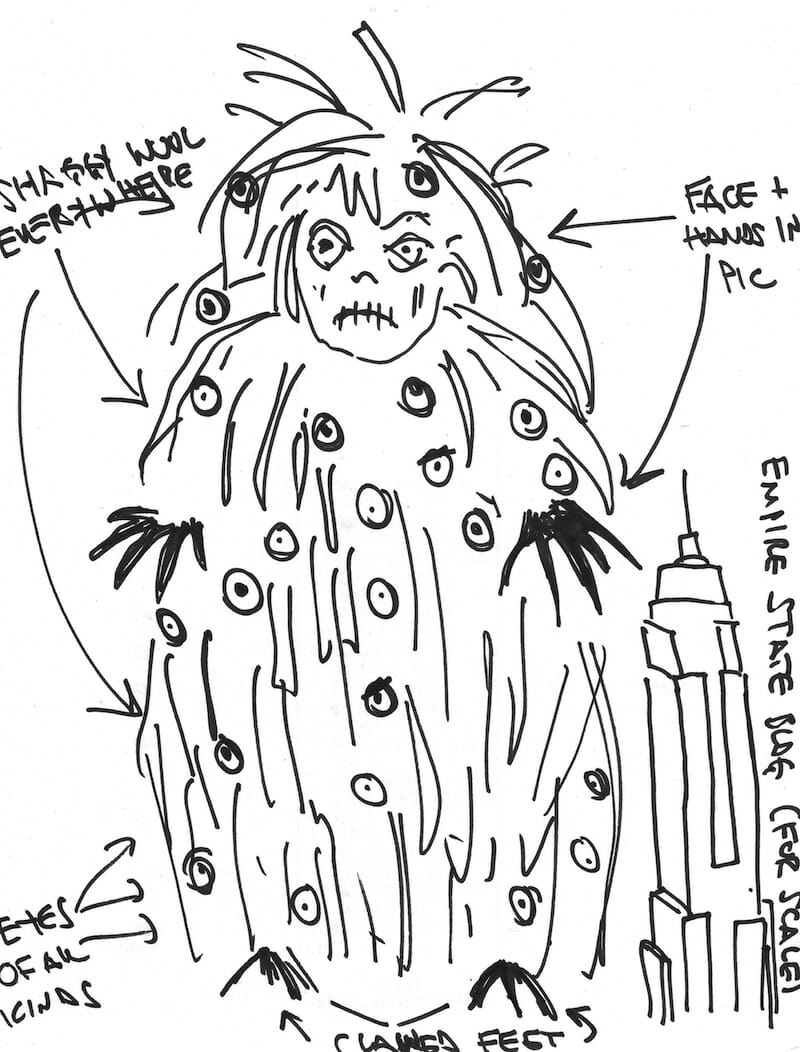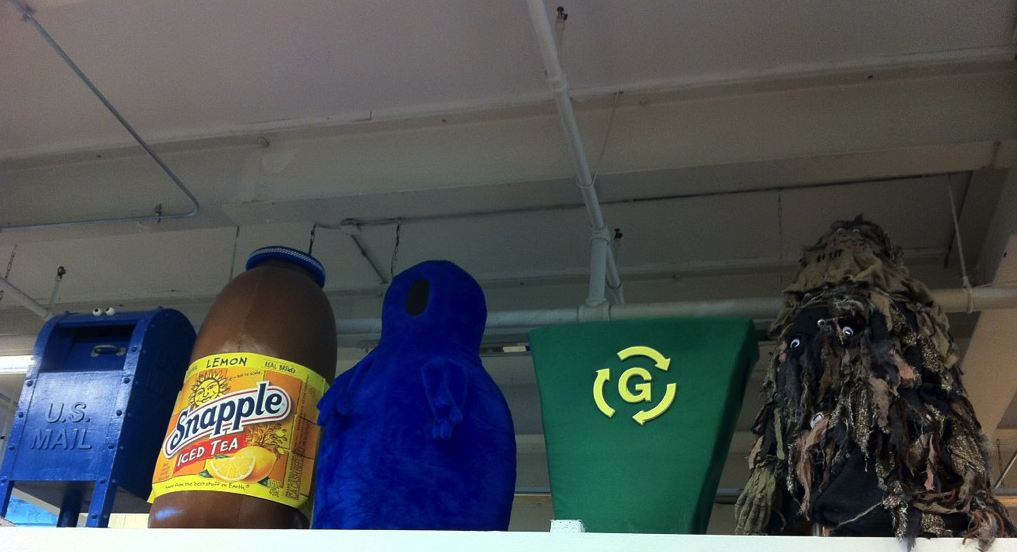Woollie: Behind the World’s Most Terrifying Sitcom Mascot
Tell-all interview with Robert Carlock, “30 Rock” co-creator, about his terrifying mascot, Woollie.
Woollie: Behind the World’s Most Terrifying Sitcom Mascot
Tell-all interview with Robert Carlock, “30 Rock” co-creator, about his terrifying mascot, Woollie.

When Woollie enters a room, heads turn. How could they not? Woollie’s hulking body, made up of raggedy scraps of densely-knit fabric, sways mightily as he shuffles back and forth. If you feel like Woollie is staring at you, well, yes, he is. He has hundreds of eyes, all peering out from different levels of grey wool, and they don’t blink.
Among other things, Woollie lacks eyelids. Woollie doesn’t speak or, at least, no one has heard him speak. He just shakes and stares and haunts your dreams.
Which is precisely how “30 Rock” co-creator and Emmy-winning television writer and producer Robert Carlock wants it. “I don’t think of Woollie as a mascot,” Carlock says in a phone interview for which he graciously agreed to talk about a glorified prop that he invented about three years ago. “He’s a real sentient creature.” Carlock pauses, correcting himself. “He or it,” he says. “Woollie is probably a hermaphrodite.”
Carlock dreamt Woollie up as a bit player in the finale of the fifth season of “30 Rock,” an episode called “Respawn.” (To view episode, go here.)
It all started with this sketch, exclusive to Modern Farmer:

The mascot – a puppet with a person inside – appears for only a few moments in a few scenes of this episode. Woollie shimmies behind Jenna (Jane Krakowski) as she appears in a clip singing during the “Wool Bowl,” a fictitious college football game. (Per usual, Jenna is clueless about the social import of her presence; the announcer introduces her as “a singer, everyone!”) Then, later, when Jenna gets asked to be “the celebrity face” of wool, Woollie sits alongside an animatronic sheep (more on that later) and the head of the Wool Council (played by the stately Victor Garber) at a grand table.
For so little screen time, Woollie made a big impression on “30 Rock” fans (me) and Carlock himself. “Woollie has nothing to do with the story, really,” Carlock says. “I was trying to think of a not-terribly sexy thing that Jenna could be celebrity face of. It was always fun that she would get any kind of attention. So, as opposed to the Cotton Bowl, we had the Wool Bowl.” Like everything in the show, even the throwaway bits get great attention from the staff. While Woollie doesn’t do much, the Wool Council does move the plot along – Jenna is forced to be normal (or “wool”) and that tests her relationship with cross-dressing Paul L’Astname (Will Forte).
But that is only one of multiple overlapping plots. Carlock brushes off the suggestion that it was taxing to come up with Woollie – “we work like 16 hours, we could take 15 minutes” – but does admit that they had great freedom as a show to go in these strange directions. Case in point: the animatronic sheep.
The sheep gets even less screen time (it appears in a scene showing the Wool Council discussing the “lifestyle clause” and the alternative sexual escapades of celebrity wool spokesperson Jenna) than Woollie but came at far greater expense (members of the prop department, after all, are “Saturday Night Live” pros). “I wanted a real sheep,” Carlock says. “But there’s some city code, so we couldn’t have a hooved animal or whatever. We tracked down, in LA, the company that made the polar bear from ‘Lost’ who made us a very realistic but not totally convincing sheep sitting quietly at the table.”
“Not totally convincing” understates the case. Like Woollie, this sheep has a certain terrifying quality. Let us look again:
But that animatronic sheep didn’t come easily. “We had to fly it in. We may have spent money on flying an operator, too,” Carlock says. “It came in like a super star, that thing. We were all waiting for that robot sheep so we could start shooting.” And even when it came, getting the remote-controlled machine to work was no small feat. It was supposed to nod and turn to look at Jenna, but because the sheep’s head moved so slowly, none of that was possible.
The result, though, is marvelously fake: just one long, weird look at the camera.
And what of the technical demands of Woollie? “It was more like a mask than a costume,” Carlocks says. “A mask of wool and eyes.” “Our wardrobe people were pretty used to weird requests so they took [my drawing] and made it better,” he says. Originally, he had wanted “some fangs” but the puppet maker convinced him it wouldn’t show through the mass of wool. Two things that weren’t visible on TV were Woollie’s hands – “terrifying, gnarled claws” – which were a wardrobe employee’s idea. And what was it like shooting with Woollie, a robot sheep and award-winning actor Victor Garber? Garber’s meliflouous voice declaring things “very wool” perfectly suited the classy environs of the Wool Council. “He really leaned into ‘very wool,’” affirms Carlock.
In terms of casting, Carlock knew Garber a bit personally – “he lived across the street from me” – and found his dignity and good looks to be right. “He had all the skills and looked great in a suit, next to a sheep and a monster,” Carlock says. “He might have given an amused raised eyebrow when we asked him to do it, but he was very game.”

These days, Woollie is not, as Carlock imagines, roaming the hillsides, feasting on pigeons. Woollie’s whereabouts are not totally known, but it appears to be in a Canadian storage facility. In our hearts, though, Woollie is very much alive, looking through us with those many eyes. (“The prop was the most terrifying thing I had ever seen,” writes producer Luke del Tredici in an email.) Even after the episode, Carlock says he was “constantly thinking about Woollie.”
“Our office was in old bread factory and we had space where we put old costumes. Woollie was up there, next to the Snapple bottle, Greenzo. We could see Woollie looking down on us and it was very creepy at night.”
Sadly, Woollie never made it back on the air. “It was hard to come with a reason. At some point, we did want to see him in the last episodes, maybe in the crowd, walking through.” But those fleeting moments with Woollie worked to affirm Carlock and the crew’s greater faith in the work of “30 Rock” – work that will hopefully continue as Carlock and Tina Fey are starting on another NBC sitcom. As its fans can attest to, the show committed to its world totally, filling each episode with dense jokes and recurring plot lines and shows-within-shows and fake catchphrases that became real catchphrases (“I want to go to there,” “Blergh,” “Jump up your mother!”). The effort that went into creating Woollie and shipping a robot sheep from across the country for one scene embodies that ethos.
“It was something we could do. We could have Victor sitting there, a guy in a wool costume, and yup, a mechanical sheep sitting there all day,” Carlock says. “We knew moral right was on our side. We knew history would judge us favorably.”
Bonus: More Carlock on Woollie
“You only have so much control over Woollie.”
“A real magical creature.”
“He’s very unruly in meetings.”
“No, it’s an evolutionary thing. If you’re the only member of your species and you have hundreds of eyes, that will make you insane. You are seeing everything around you. Woollie lives in a prison of sight.”
“He’s made of wool but it’s not nice wool.”
“There is a stench.”
“He doesn’t sleep.”
“There is a great loneliness with Woollie. He can’t reproduce.”
“Also, a sadness. A quiet dignity.”
“I’ve thought a lot about Woollie. I’m thinking about Woollie most days.”
Follow us

This work is licensed under a Creative Commons Attribution-NoDerivatives 4.0 International License.
Want to republish a Modern Farmer story?
We are happy for Modern Farmer stories to be shared, and encourage you to republish our articles for your audience. When doing so, we ask that you follow these guidelines:
Please credit us and our writers
For the author byline, please use “Author Name, Modern Farmer.” At the top of our stories, if on the web, please include this text and link: “This story was originally published by Modern Farmer.”
Please make sure to include a link back to either our home page or the article URL.
At the bottom of the story, please include the following text:
“Modern Farmer is a nonprofit initiative dedicated to raising awareness and catalyzing action at the intersection of food, agriculture, and society. Read more at <link>Modern Farmer</link>.”
Use our widget
We’d like to be able to track our stories, so we ask that if you republish our content, you do so using our widget (located on the left hand side of the article). The HTML code has a built-in tracker that tells us the data and domain where the story was published, as well as view counts.
Check the image requirements
It’s your responsibility to confirm you're licensed to republish images in our articles. Some images, such as those from commercial providers, don't allow their images to be republished without permission or payment. Copyright terms are generally listed in the image caption and attribution. You are welcome to omit our images or substitute with your own. Charts and interactive graphics follow the same rules.
Don’t change too much. Or, ask us first.
Articles must be republished in their entirety. It’s okay to change references to time (“today” to “yesterday”) or location (“Iowa City, IA” to “here”). But please keep everything else the same.
If you feel strongly that a more material edit needs to be made, get in touch with us at [email protected]. We’re happy to discuss it with the original author, but we must have prior approval for changes before publication.
Special cases
Extracts. You may run the first few lines or paragraphs of the article and then say: “Read the full article at Modern Farmer” with a link back to the original article.
Quotes. You may quote authors provided you include a link back to the article URL.
Translations. These require writer approval. To inquire about translation of a Modern Farmer article, contact us at [email protected]
Signed consent / copyright release forms. These are not required, provided you are following these guidelines.
Print. Articles can be republished in print under these same rules, with the exception that you do not need to include the links.
Tag us
When sharing the story on social media, please tag us using the following: - Twitter (@ModFarm) - Facebook (@ModernFarmerMedia) - Instagram (@modfarm)
Use our content respectfully
Modern Farmer is a nonprofit and as such we share our content for free and in good faith in order to reach new audiences. Respectfully,
No selling ads against our stories. It’s okay to put our stories on pages with ads.
Don’t republish our material wholesale, or automatically; you need to select stories to be republished individually.
You have no rights to sell, license, syndicate, or otherwise represent yourself as the authorized owner of our material to any third parties. This means that you cannot actively publish or submit our work for syndication to third party platforms or apps like Apple News or Google News. We understand that publishers cannot fully control when certain third parties automatically summarize or crawl content from publishers’ own sites.
Keep in touch
We want to hear from you if you love Modern Farmer content, have a collaboration idea, or anything else to share. As a nonprofit outlet, we work in service of our community and are always open to comments, feedback, and ideas. Contact us at [email protected].by Reyhan Harmanci, Modern Farmer
December 10, 2013
Modern Farmer Weekly
Solutions Hub
Innovations, ideas and inspiration. Actionable solutions for a resilient food system.
ExploreExplore other topics
Share With Us
We want to hear from Modern Farmer readers who have thoughtful commentary, actionable solutions, or helpful ideas to share.
SubmitNecessary cookies are absolutely essential for the website to function properly. This category only includes cookies that ensures basic functionalities and security features of the website. These cookies do not store any personal information.
Any cookies that may not be particularly necessary for the website to function and are used specifically to collect user personal data via analytics, ads, other embedded contents are termed as non-necessary cookies.